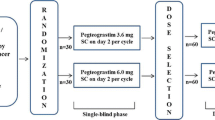Abstract
Balugrastim is a once-per-cycle, fixed-dose recombinant protein comprising human serum albumin and granulocyte colony-stimulating factor under development for prevention of severe neutropenia in cancer patients receiving myelosuppressive chemotherapy. This phase II, multicenter, active-controlled, dose-finding pilot study evaluated balugrastim safety and efficacy versus pegfilgrastim in breast cancer patients scheduled to receive myelosuppressive chemotherapy and investigated two doses with similar efficacy to pegfilgrastim for a subsequent phase III study. Patients received four cycles of doxorubicin/docetaxel chemotherapy and with each successive cycle were randomized sequentially to escalating doses of balugrastim [30 (n = 11), 40 (n = 21), or 50 mg (n = 20)] or a fixed dose of pegfilgrastim [6 mg (n = 26)] post-chemotherapy. Balugrastim doses were escalated as planned. The incidence of adverse events was similar among the balugrastim groups and between all balugrastim doses and pegfilgrastim. The most frequently reported adverse events were neutropenia, alopecia, and nausea. During cycle 1, severe neutropenia (absolute neutrophil count of <0.5 × 109/L) occurred in 40, 67, and 50 % and febrile neutropenia occurred in 20.0, 9.5, and 10.0 % of patients receiving balugrastim 30, 40, and 50 mg, respectively; in patients receiving pegfilgrastim, 48 % experienced severe neutropenia and 8 % experienced febrile neutropenia. Duration of severe neutropenia (DSN) for each treatment group was 0.9, 1.6, 1.1, and 0.9 days, respectively. In the remaining three chemotherapy cycles, DSN was ≤1 day across all treatment groups. Balugrastim 50 mg was comparable to pegfilgrastim in terms of safety and overall efficacy in breast cancer patients receiving myelosuppressive chemotherapy.


Similar content being viewed by others
References
Kuderer NM, Dale DC, Crawford J, Cosler LE, Lyman GH. Mortality, morbidity, and cost associated with febrile neutropenia in adult cancer patients. Cancer. 2006;106(10):2258–66. doi:10.1002/cncr.21847.
Schelenz S, Giles D, Abdallah S. Epidemiology, management and economic impact of febrile neutropenia in oncology patients receiving routine care at a regional UK cancer centre. Ann Oncol. 2012;23(7):1889–93. doi:10.1093/annonc/mdr520.
NCCN Clinical Practice Guidelines in Oncology. Myeloid growth factors v.2.2014. National Comprehensive Cancer Network. 2014. www.nccn.org/professionals/physician_gls/f_guidelines.asp. Accessed 5 Feb 2015.
Aapro MS, Bohlius J, Cameron DA, Dal LL, Donnelly JP, Kearney N, et al. 2010 update of EORTC guidelines for the use of granulocyte-colony stimulating factor to reduce the incidence of chemotherapy-induced febrile neutropenia in adult patients with lymphoproliferative disorders and solid tumours. Eur J Cancer. 2011;47(1):8–32. doi:10.1016/j.ejca.2010.10.013.
Phillips R, Hancock B, Graham J, Bromham N, Jin H, Berendse S. Prevention and management of neutropenic sepsis in patients with cancer: summary of NICE guidance. BMJ. 2012;345:e5368.
Crawford J, Ozer H, Stoller R, Johnson D, Lyman G, Tabbara I, et al. Reduction by granulocyte colony-stimulating factor of fever and neutropenia induced by chemotherapy in patients with small-cell lung cancer. N Engl J Med. 1991;325(3):164–70. doi:10.1056/NEJM199107183250305.
Trillet-Lenoir V, Green J, Manegold C, Von PJ, Gatzemeier U, Lebeau B, et al. Recombinant granulocyte colony stimulating factor reduces the infectious complications of cytotoxic chemotherapy. Eur J Cancer. 1993;29A(3):319–24.
Yang BB, Kido A. Pharmacokinetics and pharmacodynamics of pegfilgrastim. Clin Pharmacokinet. 2011;50(5):295–306. doi:10.2165/11586040-000000000-00000.
Neupogen [package insert]. (2013) Amgen Inc., Thousand Oaks, CA.
Neulasta [package insert]. (2014) Amgen Inc., Thousand Oaks, CA.
Kratz F. Albumin as a drug carrier: design of prodrugs, drug conjugates and nanoparticles. J Control Release. 2008;132(3):171–83. doi:10.1016/j.jconrel.2008.05.010.
Pukac L, Barash S, Avisar N, et al. Albumin-fusion r-metHuG-CSF (balugrastim)—a novel long-acting once-per-cycle fixed dose filgrastim: pharmacokinetics and pharmacodynamics in breast cancer patients [poster]. Presented at: Annual International Symposium on Supportive Care in Cancer. New York, NY, 28–30 June 2012.
Pukac L, Barash S, Avisar N, Emmert KH, Allgaier H, Bock J, et al. Balugrastim—a long-acting, once-per-cycle, fixed-dose filgrastim: pharmacokinetics and pharmacodynamics in patients with breast cancer [abstract 970]. Support Care Cancer. 2012;20(suppl 1):S231.
Alba E, Martin M, Ramos M, Adrover E, Balil A, Jara C, et al. Multicenter randomized trial comparing sequential with concomitant administration of doxorubicin and docetaxel as first-line treatment of metastatic breast cancer: a Spanish Breast Cancer Research Group (GEICAM-9903) phase III study. J Clin Oncol. 2004;22(13):2587–93. doi:10.1200/JCO.2004.08.125.
Nabholtz JM, Falkson C, Campos D, Szanto J, Martin M, Chan S, et al. Docetaxel and doxorubicin compared with doxorubicin and cyclophosphamide as first-line chemotherapy for metastatic breast cancer: results of a randomized, multicenter, phase III trial. J Clin Oncol. 2003;21(6):968–75.
Aapro MS, Cameron DA, Pettengell R, Bohlius J, Crawford J, Ellis M, et al. EORTC guidelines for the use of granulocyte-colony stimulating factor to reduce the incidence of chemotherapy-induced febrile neutropenia in adult patients with lymphomas and solid tumours. Eur J Cancer. 2006;42(15):2433–53. doi:10.1016/j.ejca.2006.05.002.
Green MD, Koelbl H, Baselga J, Galid A, Guillem V, Gascon P, et al. A randomized double-blind multicenter phase III study of fixed-dose single-administration pegfilgrastim versus daily filgrastim in patients receiving myelosuppressive chemotherapy. Ann Oncol. 2003;14(1):29–35.
Holmes FA, Jones SE, O’Shaughnessy J, Vukelja S, George T, Savin M, et al. Comparable efficacy and safety profiles of once-per-cycle pegfilgrastim and daily injection filgrastim in chemotherapy-induced neutropenia: a multicenter dose-finding study in women with breast cancer. Ann Oncol. 2002;13(6):903–9.
Johnston E, Crawford J, Blackwell S, Bjurstrom T, Lockbaum P, Roskos L, et al. Randomized, dose-escalation study of SD/01 compared with daily filgrastim in patients receiving chemotherapy. J Clin Oncol. 2000;18(13):2522–8.
Acknowledgments
This study was sponsored by Teva Branded Pharmaceutical Products R & D, Inc. Medical writing assistance was provided by Lisa Feder, PhD of Peloton Advantage, LLC, and was funded by Teva Branded Pharmaceutical Products R & D, Inc. Teva provided a full review of the article.
Conflict of interest
Steven Barash, Liat Adar, Peter Bias, and Noa Avisar are employees of Teva Pharmaceuticals. Oleg Gladkov, Vladimir Moiseyenko, and Igor N. Bondarenko declare that they have no conflict of interest. Yaroslav Shparyk has received consulting fees/honoraria as a principal investigator from Teva Pharmaceuticals.
Author information
Authors and Affiliations
Corresponding author
Rights and permissions
About this article
Cite this article
Gladkov, O., Moiseyenko, V., Bondarenko, I.N. et al. Phase II dose-finding study of balugrastim in breast cancer patients receiving myelosuppressive chemotherapy. Med Oncol 32, 181 (2015). https://doi.org/10.1007/s12032-015-0623-x
Received:
Accepted:
Published:
DOI: https://doi.org/10.1007/s12032-015-0623-x




